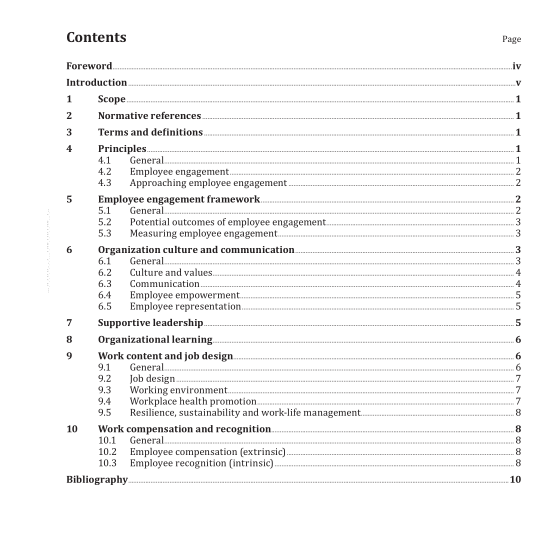ISO 23326:2022 pdf download.Human resource management — Employee engagement — Guidelines
This document provides guidance on creating a mutually beneficial environment that encourages everyone to be connected with the objectives, purpose and values of the organization, and for the organization to support its people in a manner which provides quality work and opportunities for development and professional fulfilment. Organizations can use the guidance to determine what is practical or material to the organization’s internal and external context regardless of its size, type,structure, nature or complexity, whether in the public, private or voluntary sector.
The document applies to anyone who works for or on behalf of an organization. The guidance contained in this document is not intended to infringe upon national labour laws, established collective agreements or collective bargaining.
2 Normative references
There are no normative references in this document.
3 Terms and definitions
For the purposes of this document, the following terms and definitions apply.
ISO and IEC maintain terminology databases for use in standardization at the following addresses:
— ISO Online browsing platform: available at https:// www .iso .org/ obp
— IEC Electropedia: available at https:// www .electropedia .org/
3.1 social dialogue
negotiation, consultation or simply exchange of information between or among representatives of governments, employers and employees, on matters of common interest relating to economic and social policy
[SOURCE: ISO 26000:2010, 2.17, modified — Note 1 to entry removed.]
4 Principles
4.1 General
The following guiding principles apply:
— All organizational stakeholders have a role to play in improving employee engagement, principally the senior leaders, managers, HR experts, employees and employee representatives.
— Employee engagement should be embedded within the organization’s culture and enacted through the organizational policies.
— Two-way communication is an essential part of employee engagement.
— Organizations will need to regularly assess progress against their employee engagement objectives. This can be achieved through surveys or interviews which should be bound by anonymity and confidentiality at the individual employee level.
— The health and well-being of the workforce is a priority consideration throughout this document. Organizations should therefore regularly assess the health risks associated with over-engagement over a prolonged period of time.
— Organizations should be aware of all legal provisions for data protection and privacy.
4.2 Employee engagement From the perspective of this document, employee engagement is predicated from an inclusive workplace approach which informs, promotes and enables conditions where all members of an organization have a constructive voice and contribute productively in a manner meaningful to them. Engaged employees are more likely to be committed to their organization’s goals and values and motivated to contribute to sustainable organizational performance. This is a two-way process whereby the organization provides an inclusive, supportive environment and individuals respond by freely providing discretionary effort [17] .
4.3 Approaching employee engagement Engagement can be measured by the level of an individual’s vigour, dedication and absorption in their work, [15] in line with the seminal work of Schaufeli et al. [15] Vigour refers to employees having high levels of energy and resilience while working and the willingness to invest effort in carrying out their roles. Dedication refers to employees being strongly involved in their work and experiencing a source of pride and challenge. Employees who are absorbed will be fully concentrated and engrossed in their work.
5 Employee engagement framework
5.1 General The framework which guides this document is presented in Figure 1. The figure highlights the association between some of the ‘conditions’ related to work engagement which organizations can change and enhance, and these are discussed in more detail in Clauses 6 to 10.
5.2 Potential outcomes of employee engagement
A number of potential outcomes of employee engagement can be identified:
— individual satisfaction with work and job quality can increase [6] ;
— organizational performance and future sustainability can improve where there are higher levels of employee engagement;
— improved employee retention;
— improved customer service can be reported;
— productivity can be increased.
5.3 Measuring employee engagement
The use of qualitative and quantitative methods of assessment can help to build an understanding of employee engagement. These include but are not limited to:
— focus groups, to gain a deeper understanding of employee experiences;
— employee surveys, either internally developed or existing survey instruments through third-party providers;
— validated instruments related to work engagement, such as the Utrecht Work Engagement Scale [15] .ISO 23326 pdf download.ISO 23326 pdf download
